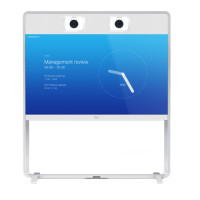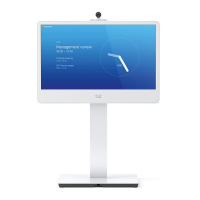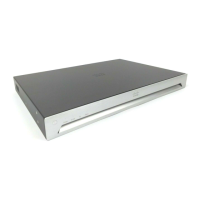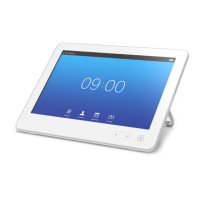D15335.02 Cisco TelePresence MX700 and MX800 API Reference Guide CE8.0, FEBRUARY 2016.
Copyright © 2016 Cisco Systems, Inc. All rights reserved. 60
Cisco TelePresence MX700 and MX800
API Reference Guide
xConfiguration Network [1] IPv6 DHCPOptions
Retrieve a set of DHCP options, for example NTP and DNS server addresses, from a DHCPv6
server.
Requires user role: ADMIN
Default value: On
USAGE:
xConfiguration Network n IPv6 DHCPOptions: DHCPOptions
where
n
: Index that identifies the network. Range: 1..1
DHCPOptions
: Off/On
Off: Disable the retrieval of DHCP options from a DHCPv6 server.
On: Enable the retrieval of a selected set of DHCP options from a DHCPv6 server.
xConfiguration Network [1] MTU
Define the Ethernet MTU (Maximum Transmission Unit).
Requires user role: ADMIN
Default value: 1500
USAGE:
xConfiguration Network n MTU: MTU
where
n
: Index that identifies the network. Range: 1..1
MTU
: Integer (576..1500)
Set a value for the MTU (bytes).
xConfiguration Network [1] QoS Mode
The QoS (Quality of Service) is a method which handles the priority of audio, video and data in
the network. The QoS settings must be supported by the infrastructure. Diffserv (Differentiated
Services) is a computer networking architecture that specifies a simple, scalable and coarse-
grained mechanism for classifying, managing network traffic and providing QoS priorities on
modern IP networks.
Requires user role: ADMIN
Default value: Diffserv
USAGE:
xConfiguration Network n QoS Mode: Mode
where
Mode
: Off/Diffserv
Off: No QoS method is used.
Diffserv: When you set the QoS Mode to Diffserv, the Network QoS Diffserv Audio,
Network QoS Diffserv Video, Network QoS Diffserv Data, Network QoS Diffserv
Signalling, Network QoS Diffserv ICMPv6 and Network QoS Diffserv NTP settings are
used to prioritize packets.
xConfiguration Network [1] QoS Diffserv Audio
This setting will only take effect if Network QoS Mode is set to Diffserv.
Define which priority Audio packets should have in the IP network.
The priority for the packets ranges from 0 to 63 - the higher the number, the higher the prior-
ity. The recommended class for Audio is CS4, which equals the decimal value 32. If in doubt,
contact your network administrator.
The priority set here might be overridden when packets are leaving the network controlled by
the local network administrator.
Requires user role: ADMIN
Default value: 0
USAGE:
xConfiguration Network n QoS Diffserv Aud io: Audio
where
Audio
: Integer (0..63)
Set the priority of the audio packets in the IP network - the higher the number, the
higher the priority. The default value is 0 (best effort).

